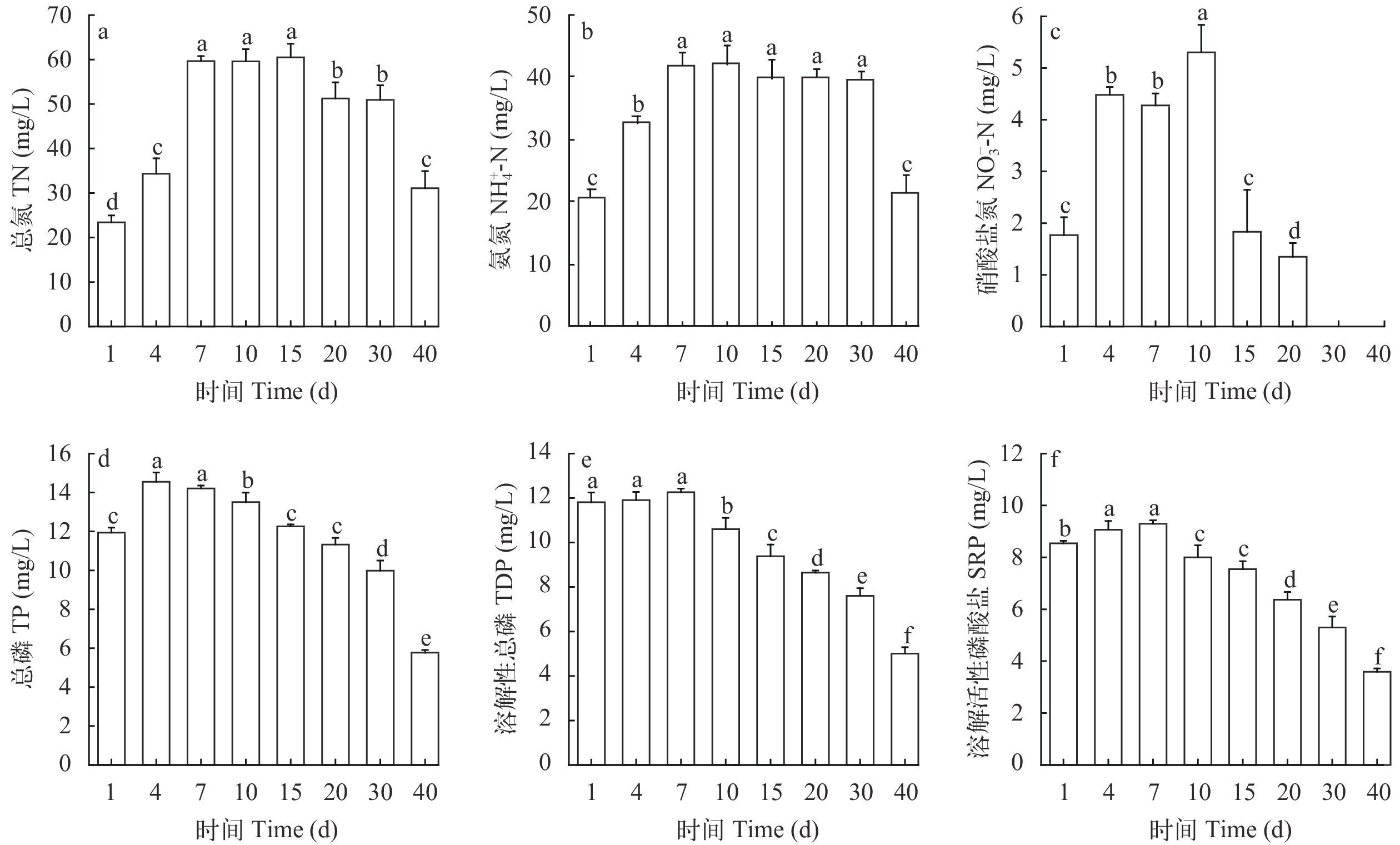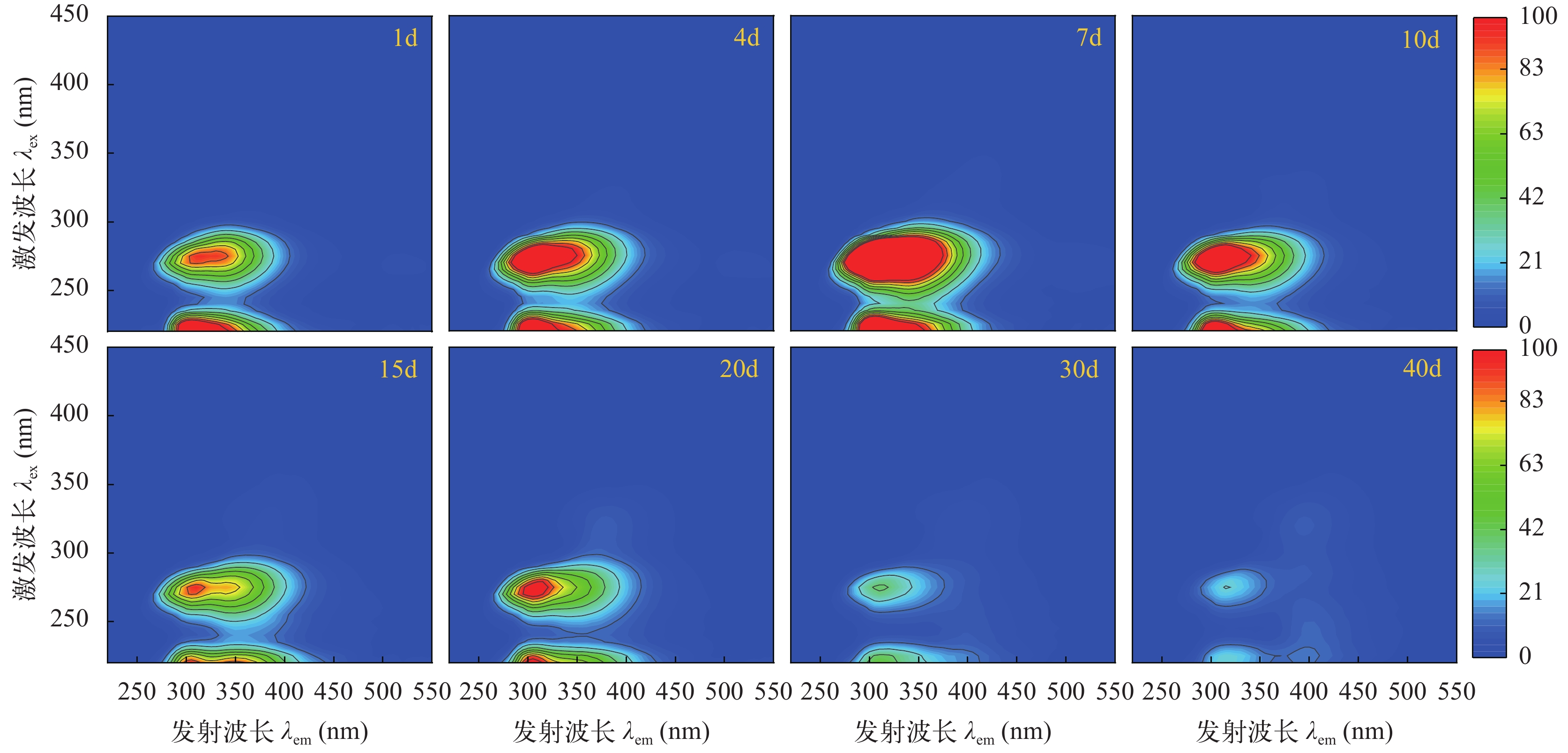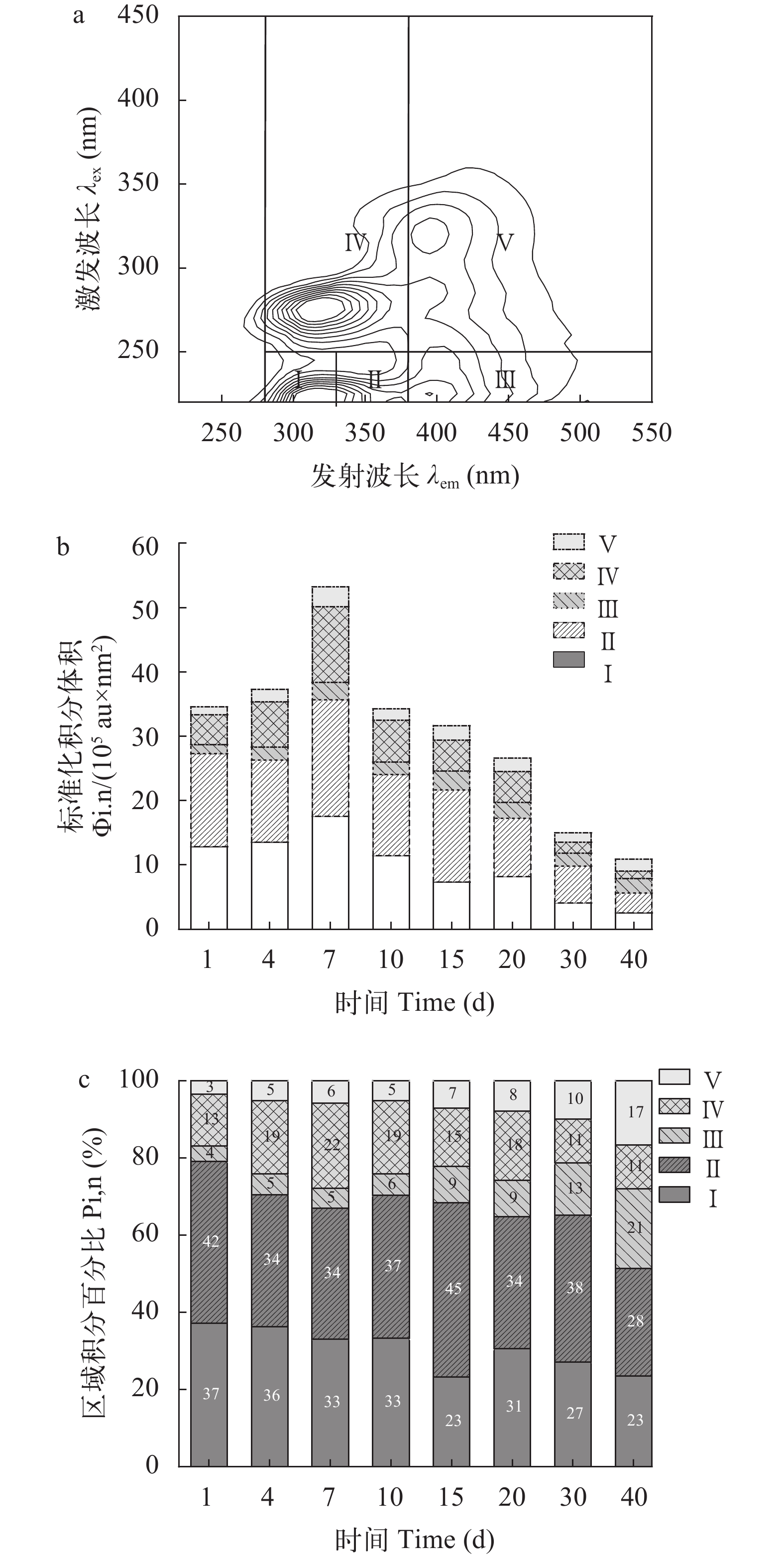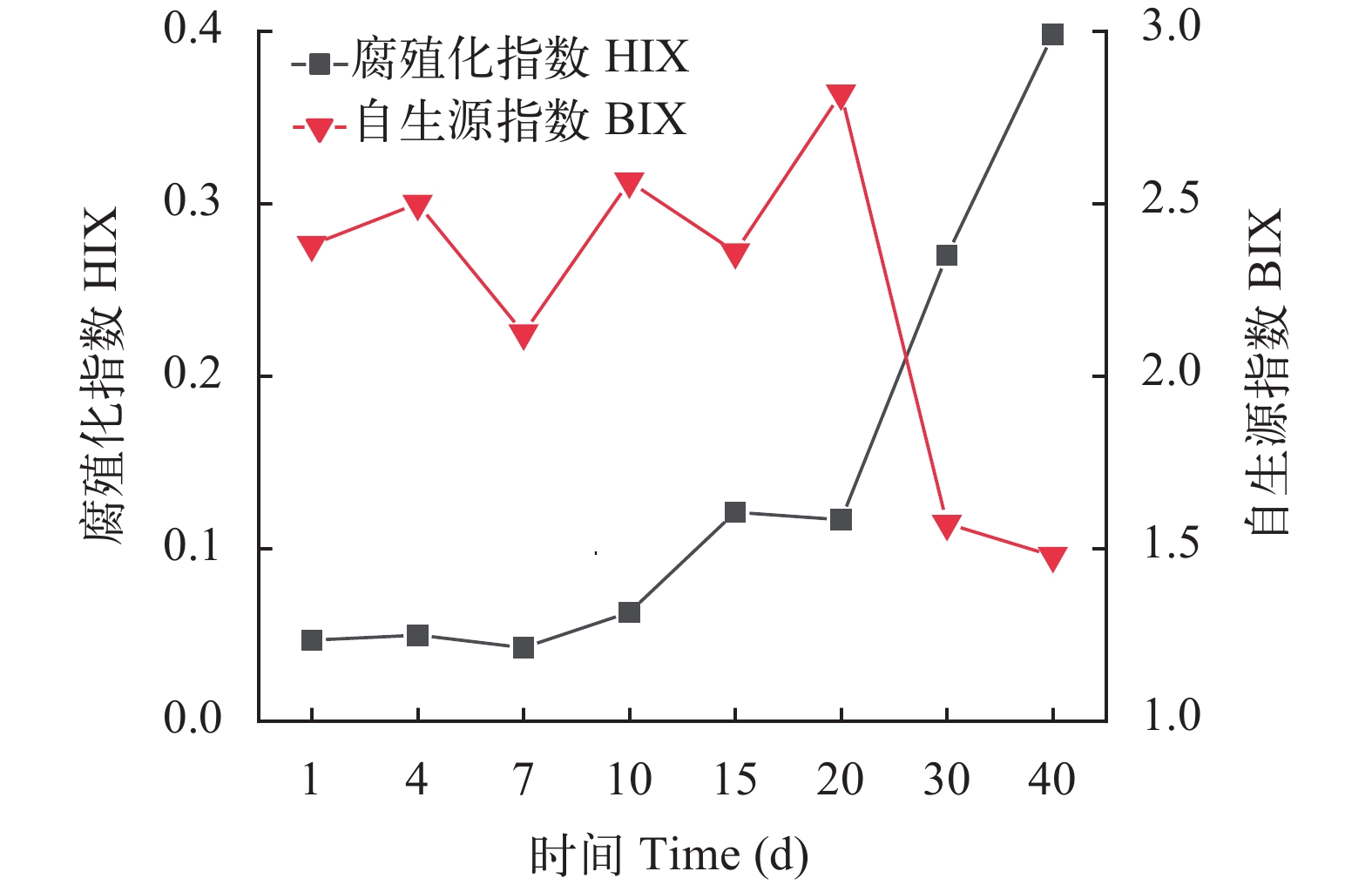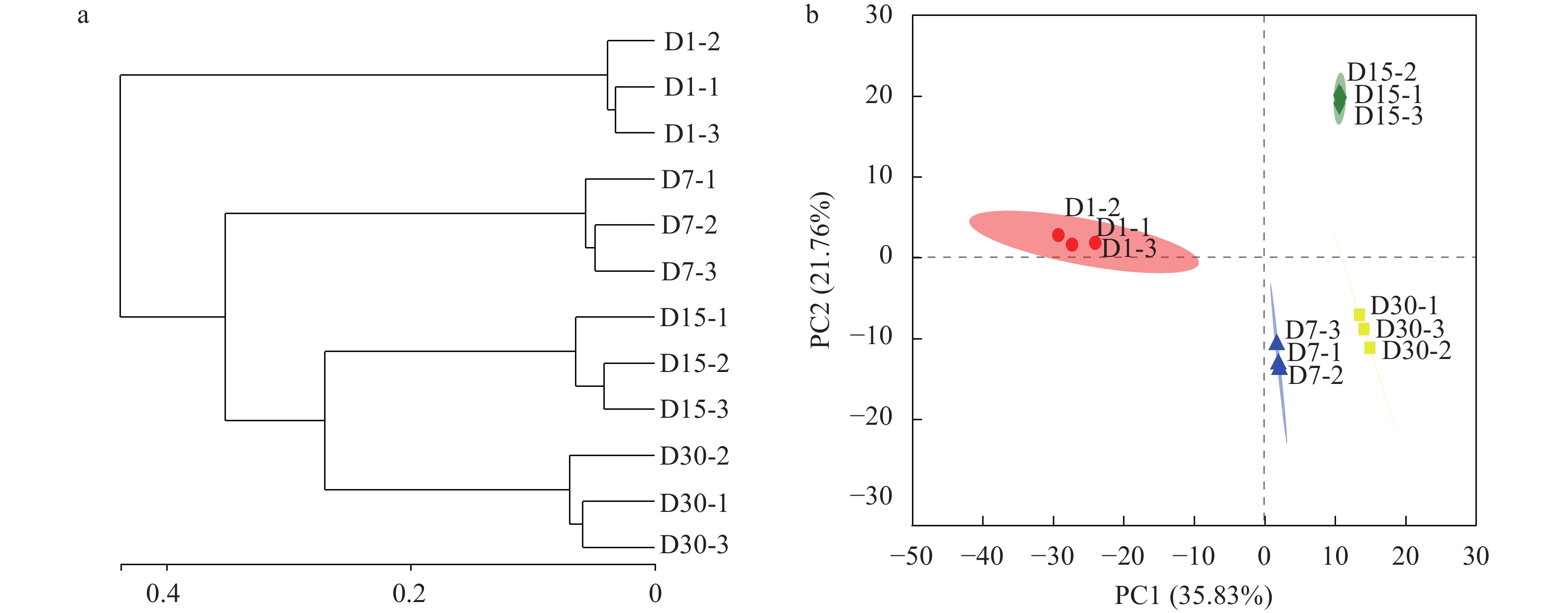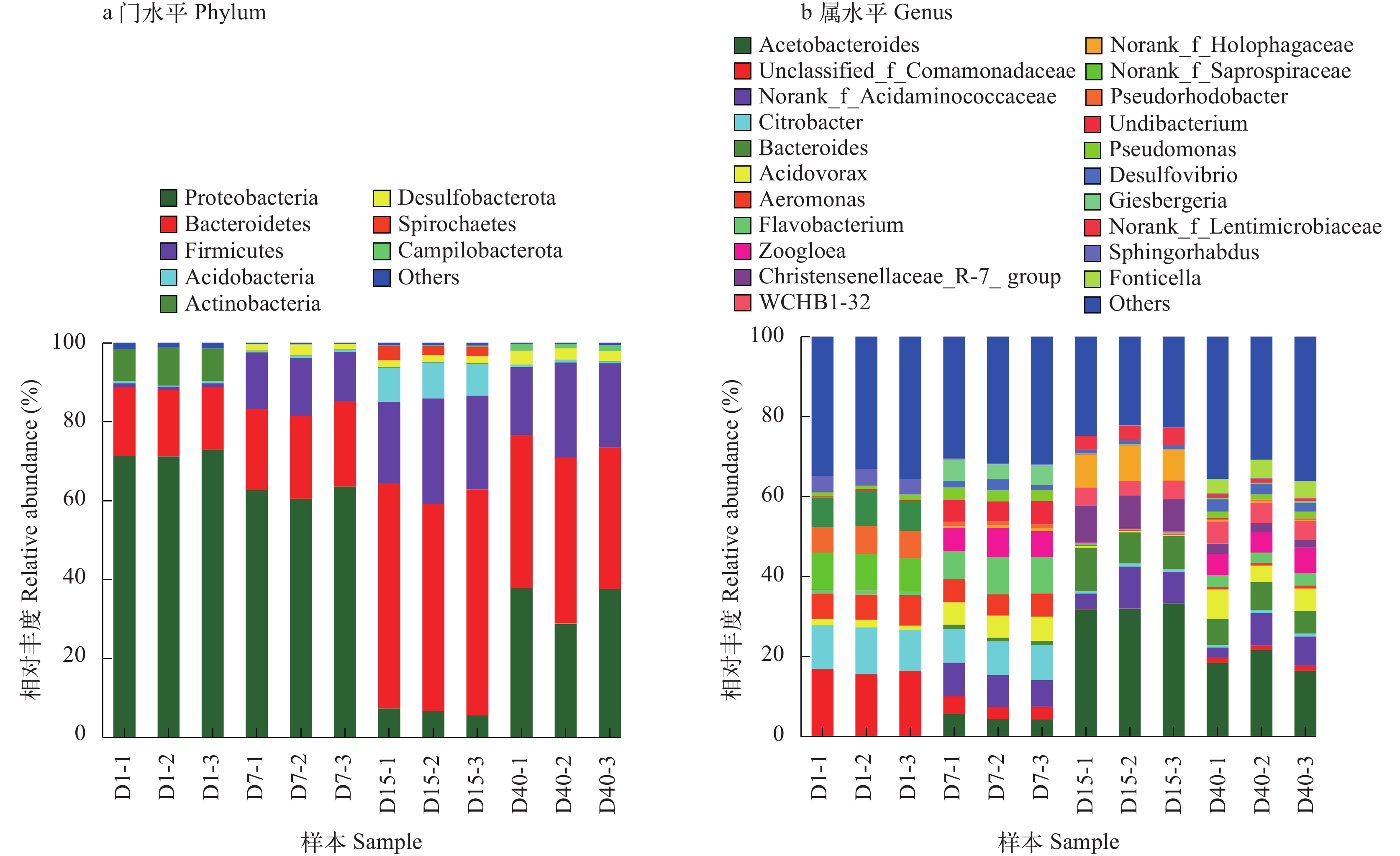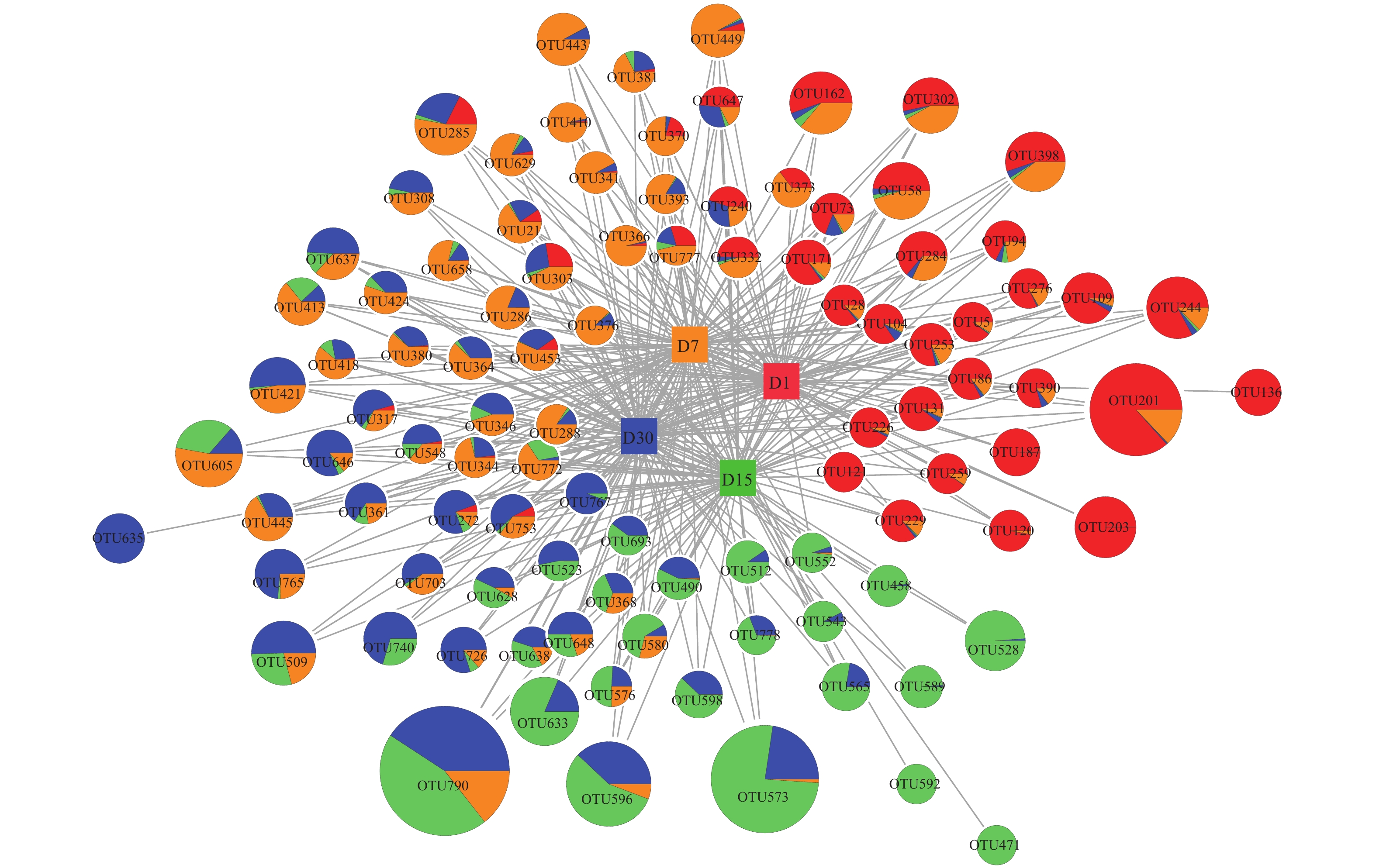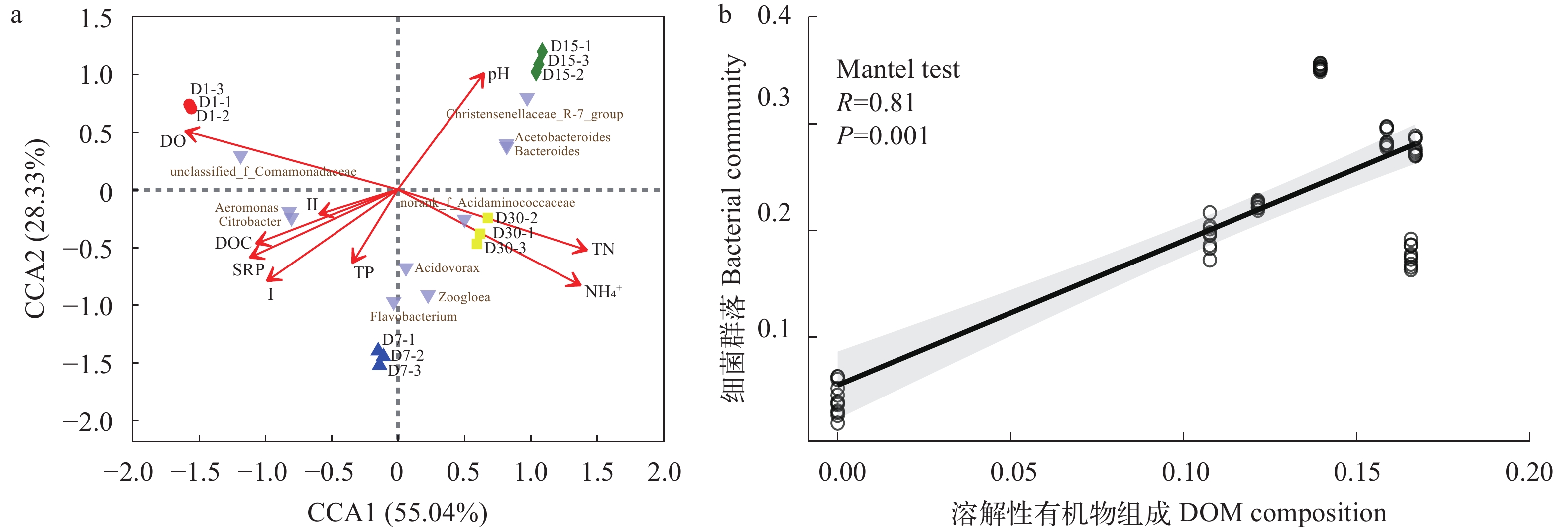DISSOLVED ORGANIC MATTER RELEASE AND BACTERIAL COMMUNITY SHIFTS DURING THE DECOMPOSITION OF CLADOPHORA
-
摘要: 通过室内培养模拟了高密度刚毛藻聚积腐烂过程, 研究了刚毛藻在不同腐烂时间段下的溶解性有机物(DOM)的释放和附着微生物的群落变化。结果表明: 在40d的分解实验中, 刚毛藻生物量(干重)减少, 且表现为前期损失快, 后期损失减缓的趋势。在实验结束时(40d), 干物质残留率为43.15%, 质量损失了56.85%。在刚毛藻分解过程中, DOM在7—10d内快速释放达到最大值, 而后降低。DOM的组分也变得复杂, 荧光峰从区域Ⅰ、Ⅱ和Ⅳ逐渐转移到区域Ⅲ和Ⅴ。大量的简单芳香蛋白, 如酪氨酸类物质被微生物转化为各种代谢物, 并产生了腐殖质类物质。刚毛藻附着微生物优势菌为变形菌门(Proteobacteria)、拟杆菌门(Bacteroidetes)和厚壁菌门(Firmicutes), 相对丰度分别为6.54%—71.62%、16.83%—55.50%和0.95%—20.91%。在腐烂过程的不同阶段中, 微生物的组成差异显著, 表现为前期主要是Proteobacteria占主导优势, 实验后期是Bacteroidetes占主导优势, 细菌群落的演替与DOM组成的变化相关。Abstract: The Cladophora overgrowth has become a widespread global problem. The decomposition of Cladophora biomass releases large amounts of dissolved organic matter (DOM), a key substance in the biogeochemical cycle of carbon in aquatic ecosystems, resulting in a more complex organic pollution in water bodies. Field investigations and indoor experiments have proven that one of the sources of endogenous DOM in water bodies is the biodegradation of algae. Microorganisms play an important role in the decay of aquatic plants, and bacteria differ in their metabolic preferences and affinity for substrates. Bacterial diversity and community composition may both influence and respond to changes in DOM. However, it is not clear how the microbial community and the DOM composition of the surrounding water column change during the decomposition of the Cladophora. In order to study the composition of algal-derived DOM, we simulated the decay process of Cladophora in the laboratory. The experiment was carried out in a constant temperature incubator. 10 g (fresh weight) of Cladophora was placed into sterile polyethylene plastic bottles with 500 mL of sterile water and placed in dark conditions at 25℃ to decay naturally. Three replicate samples were randomly selected for chemical and microbiological analysis at 1, 4, 7, 10, 15, 20, 30 and 40 days. We performed 16S amplicon sequencing of algal-attached microorganisms to analyse the dynamic process of microbial self-assembly on decaying algae. The results showed that during the 40-day decomposition experiment, the biomass of Cladophora decreased, and it showed a trend of rapid loss in the early stages and slowed down in the later stages. At the end of the experiment (40 days), the dry matter residual rate was 43.15% and the mass loss was 56.85%. During the decomposition process of Cladophora, DOM quickly released to the maximum within 7—10 days. The composition of DOM also became complicated, and the fluorescence peaks gradually shifted from regions Ⅰ, Ⅱ and Ⅳ to regions Ⅲ and Ⅴ. A large amount of simple aromatic proteins, such as tyrosine, were transformed into various metabolites by microorganisms, and humic substances were produced. The dominant phyla of microorganisms attached to the Cladophora were Proteobacteria, Bacteroidetes and Firmicutes, with relative abundances ranging from 6.54% to 71.62%, 16.83% to 55.50% and 0.95% to 20.91%, respectively. In different stages of the decay process, the composition of microorganisms was significantly different, which was mainly dominated by Proteobacteria in the early stage and Bacteroidetes in the late stage of the experiment. Pearson's correlation (R=0.81, P=0.001) between Bray-Curtis distance and Euclidean distance of DOM composition for bacterial communities was calculated using the Mantel test (999 ranking). The results of the Mantel test indicated that changes in DOM composition were significantly correlated with changes in the composition of the bacterial community. These findings have implications for further understanding of the characteristics of DOM released during the decay of Cladophora blooms and the relationship between DOM and microbial communities, and provide theoretical support for the management of filamentous green algae blooms.
-
Keywords:
- Decomposition /
- Dissolved organic matter /
- Attached microorganisms /
- Cladophora
-
刚毛藻(Cladophora Kütz.)属于绿藻门(Chlorophyta)石莼纲(Chlorophyceae)刚毛藻目(Cladophorales), 是一种典型的底栖附着丝状绿藻[1]。刚毛藻的过度增殖已经成为一个普遍的全球问题, 在许多地区的湖泊都有过报道, 例如贝加尔湖(东西伯利亚)、劳伦大湖区(美国)、巴德沃斯湖(英国)及我国的滇池和青海湖等[2—5]。刚毛藻过度增殖, 可以形成一个密集的藻垫, 这通常会导致遮荫、缺氧和干扰物质循环等[6]。刚毛藻在腐烂分解时释放大量的溶解性有机物(DOM), 造成水体氮磷营养盐的增加。刚毛藻分解液会抑制沉水植物的种子的萌发及幼苗的生长[7], 腐解液还会促进大肠杆菌和肠球菌的体外增殖[8]。因此, 刚毛藻的快速增殖和腐烂会造成许多环境生态问题。
溶解性有机物(Dissolved organic matter, DOM)是水生态系统中碳的生物地球化学循环中的关键物质, 是一种高度异质性的混合物, 具有不同的分子特征[9]。水体中过量的DOM会导致水中氧浓度降低, 氧化还原电位改变, 污染速率加快, 微生物丰度增加等[10]。DOM来源广泛, 不同源头所产生的有机物性质不一, 在水体中的生物地球化学行为差异较大, 故造成水体有机物污染的原因和性质较为复杂。近年来, 国内外学者对自然水体中DOM的时空分布和来源进行了大量研究[11—16]。通过野外调查及室内实验证明, 水生植物和水华藻类的生物降解是内源DOM的最主要来源, 并实验模拟了沉水植物[11]和水华蓝藻[17]腐烂过程中的溶解性有机物的变化。然而, 这些研究很少涉及到伴生微生物在分解过程中的情况。在一些湖泊水体中, 丝状绿藻刚毛藻过度增殖形成水华, 大量漂浮在水面, 或堆积在岸边, 其腐烂过程中的溶解性有机物的释放及其变化特征却鲜有报道。
水生植物的腐烂分解受pH、DO和水动力等环境因素的影响。除环境因素外, 微生物也发挥了重要作用。在水生植物腐烂分解的过程中, 可溶性有机底物是异养微生物群落的重要能量来源。由于不同细菌的代谢偏好和对底物的亲和力不同, 细菌多样性和群落组成的变化可能同时影响和响应DOM的变化[18]。然而, 在丝状刚毛藻分解过程中, 其微生物群落和周围水体DOM组成是如何变化的尚不清楚。
在本实验中, 我们研究了刚毛藻从开始腐烂至完全腐烂的过程中水体DOM的组成, 进一步认识藻源DOM在产生和降解过程中的变化。并对刚毛藻附着微生物进行了16S扩增子测序, 分析了微生物在腐烂的刚毛藻上自我组装的动态过程。研究结果对于进一步认识刚毛藻水华腐烂分解过程中释放的溶解性有机物的变化特征及其与微生物群落关系具有一定的意义和作用, 并且能够在水体发生丝状刚毛藻水华时, 为管理部门提供相应的理论支持。
1. 材料与方法
1.1 样品采集与处理
实验所用的寡枝刚毛藻(Cladophora oligoclora Kütz.)于2021年4月下旬从湖北省武汉东湖(30°55′N, 114°36′E)采集。采后带回实验室, 用自来水冲洗, 直至把附着在其表面的泥沙及其他杂质冲洗干净, 再用蒸馏水冲洗3遍, 将表面水分吸干, 称取鲜重。用蒸馏水进行浸出实验, 以更好地分析刚毛藻分解产生的成分。
室内模拟实验在恒温培养箱中进行。将10 g(鲜重)刚毛藻置于无菌聚乙烯塑料瓶中, 并加入500 mL无菌水。为防止潜在的光化学反应, 所有培养瓶均置于25℃黑暗条件下自然腐烂, 同时盖上盖子以防水分蒸发。分别在1d、4d、7d、10d、15d、20d、30d和40d随机选择3个重复样品, 进行化学和微生物分析。
1.2 理化指标的测定
This page contains the following errors:
error on line 1 at column 1: Start tag expected, '<' not foundBelow is a rendering of the page up to the first error.
1.3 荧光光谱分析
三维荧光光谱(Excitation-emission matrices, EEMs)采用Hitachi公司的F-2700型荧光光度计测定, 激发和发射分别设定在220—450 nm和220—550 nm, 扫描间隔为5 nm。每隔5个样品测量超纯水作为空白EEMs, 用以订正水样EEMs中的拉曼散射。通过Matlab软件下的drEEM工具包插值的方法去除瑞利散射[20]。
1.4 刚毛藻腐烂速率分析
刚毛藻的腐烂分解速率是通过称重每个采样时间65℃干燥24h后的样品, 利用Olson指数衰减模型描述生物量水平随时间的质量损失[11]: Wt=W0e–kt。式中,Wt是在时间t的物质干重, W0为初始干重, k是分解率(/d), t是时间。
1.5 DNA提取和扩增子测序
使用FastDNA®SPIN Kit for Soil试剂盒从0.5 g藻样中提取DNA, 随后使用NanoDrop ND-1000分光光度计(NanoDrop Technologies, Wilmington, DE, USA)检查DNA的质量和数量。委托上海美吉生物医药科技有限公司进行高通量测序, PCR扩增16S rRNA细菌的基因, 使用通用引物338F/806R(5′-ACTCCTACGGGAGGCAGCAG-3′/5′-GGACTACHVGGGTWTCTAAT-3′)。PCR方法为: 95℃预变性5min; 94℃ 30s, 55℃ 30s, 72℃ 45s, 共28个循环; 将PCR产物进行定量和均质, 利用Illumina公司的Miseq PE300平台进行测序(上海美吉生物医药科技有限公司)。
1.6 数据处理分析
荧光EEM分析在MATLAB软件中进行。Illumina测序平台进行文库测序, UCLUST基于Silva(细菌)以97%的相似度聚类得到操作分类单元(Operational Taxonomic Unit, OTU)数目, 同时生成不同分类水平的物种丰度表。运用Mothur软件评估α多样性, 用QIIME软件分析β多样性。使用Canoco4.5(Biometrics, USA)进行典范对应分析(CCA)描述微生物群落与环境因子之间的相关性。使用R中的“vegan”包基于两个距离矩阵之间的 Pearson 相关性(如细菌群落的Bray-Curtis距离)进行mantel检验。
图表数据表示为平均值±标准差, 使用SPSS 25.0软件进行单因素方差分析, 以比较理化指标随时间的动态变化, 使用Origin 2021进行折线图及柱形图的绘制, 使用软件Cytoscape3.8.2进行网络图的绘制。
2. 结果
2.1 刚毛藻分解过程中干物质的损失
刚毛藻分解过程中干物质随时间的变化(图 1)。随着分解时间的延长, 实验开始后第1、第4、第7、第10和第15天时, 枯落物残留率为60.46%、53.86%、51.11%、50.41%和45.97%, 质量损失39.54%、46.14%、48.86%、49.59% 和54.03%。在实验结束时(40d), 枯落物残留率为43.15%, 质量损失了56.85%。如图 1所示, 刚毛藻的分解率在第30天和第40天差异不明显, 其余各组的分解率都有显著差异(P<0.01)。刚毛藻腐烂分解速率具有明显的阶段性, 大致可以分为3个阶段。阶段Ⅰ: 腐烂前期, 0—4d, 这个阶段的分解速率为0.155—0.50, 平均值为0.3275, 该阶段刚毛藻生物量损失了46.14%; 阶段Ⅱ: 腐烂中期, 4—20d, 分解速率为0.041—0.095, 平均值为0.064, 该阶段生物量损失了16.16%, 刚毛藻生物量共损失了55.70%; 阶段Ⅲ: 腐烂后期, 20—40d, 分解速率为0.027—0.041, 平均值为0.033, 该阶段刚毛藻质量损失了12.52%, 生物量总损失56.85%。
2.2 上覆水中溶解氧、pH、溶解性有机碳和电导率的变化
上覆水体中溶解氧(DO)、pH、溶解性有机碳(DOC)和电导率(Cond)参数如图 2所示。在整个分解过程中, DO浓度均明显低于实验第1天(图 2a)。DO浓度在第4天时迅速下降达到1.28 mg/L, 在15—40d的DO在0.11—0.17 mg/L, 整个系统处于厌氧状态(<0.2 mg/L)。上覆水的pH在腐烂的第4天下降到最低, 为5.84, 之后持续上升到7.90, 显著高于初始pH(图 2b)。刚毛藻腐烂分解期间, 水体中DOC浓度呈现出先增加后减少的趋势, 在第4天达到最大值, 为441.48 mg/L(图 2c), Cond(图 2d)在腐烂前期迅速上升, 腐烂中期基本保持稳定, 腐烂后期下降。
2.3 上覆水中氮磷营养盐的变化
This page contains the following errors:
error on line 1 at column 1: Start tag expected, '<' not foundBelow is a rendering of the page up to the first error.
![]() 图 3
图 3This page contains the following errors:
error on line 1 at column 1: Start tag expected, '<' not foundBelow is a rendering of the page up to the first error.
柱状图上的不同小写字母代表不同的组间的显著性差异P<0.05Figure 3.This page contains the following errors:
error on line 1 at column 1: Start tag expected, '<' not foundBelow is a rendering of the page up to the first error.
The different letters on the bar indicate the significant difference at P<0.05 between different groups2.4 上覆水中溶解性有机物(DOM)的变化
EEM图中的荧光基团可以简单划分为几种类型: A. 类黄腐酸Ex(230—310 nm)/Em(380—460 nm); B1. 类酪氨酸Ex(270—290 nm)/Em(300—315 nm); B2. 类色氨酸Ex(225—240 nm)/Em(300—315 nm); C. 类腐殖酸Ex(345—450 nm)/Em(430—530 nm)[21]。从图 4可以看出, 在腐烂前期(0—4d), 水体中的溶解性有机物主要是类酪氨酸B1和类色氨酸B2, 且荧光强度逐渐增大。在腐烂中期, 溶解性有机物主要还是有B1和B2两个荧光基团组成, 但是荧光强度逐渐减小, 并且开始出现基团C类腐殖酸物质。腐烂的后期, 随着水体中溶解性有机物浓度的继续降低, B1和B2荧光基团的荧光强度减弱, C腐殖酸和A黄腐酸荧光占比逐渐增大。
为了进一步地分析EEM图中荧光物质组成变化, 我们参考前人提出的区域积分法(FRI)将EEM荧光光谱分为5个部分(图 5a)[22], 代表5种主要类型的DOM: 酪氨酸样蛋白(区域Ⅰ: Ex, 220—250 nm; Em, 280—330 nm)、色氨酸样蛋白(区域Ⅱ: Ex, 220—250 nm; Em, 330—380 nm)、黄腐酸类有机物(区域Ⅲ: Ex, 220—250 nm; Em, 380—550 nm)、微生物类副产物材料(区域Ⅳ: Ex, 250—450 nm; Em, 280—380 nm)和腐殖酸类有机物(区域Ⅴ: Ex, 250—450 nm; Em, 380—550 nm)。通过计算每个区域的累积积分强度, 算出特定的荧光区域积分体积(Φi), 对Φi进行标准化, 得到某一荧光区域积分标准体积(Φi. N; 图 5b); 最后计算出某一荧光区域的特定结构有机物的积分占总积分的比例(Pi, n; 图 5c)[23]。
在整个实验过程中, 水体中DOM浓度呈现出明显的时间格局, 实验前7天DOM浓度显著增加, 第7天之后DOM浓度持续下降。如图 4所示, B1的荧光强度在第7天达到最大, 并且随着腐烂时间的延长, 出现了A峰和C峰。如图 5c所示, 组分Ⅰ(酪氨酸类蛋白质物质)和组分Ⅱ(色氨酸类蛋白质物质)在5种组分中所占的比例逐渐减少, 组分Ⅲ(黄腐酸类物质)和组分Ⅴ类(腐殖质类物质)所占的比例逐渐增大, 组分Ⅳ(微生物代谢产物)所占的比例则是先增大后减小。在分解过程中, 刚毛藻首先向水中释放出易生物降解的类蛋白质类物质, 后被微生物转化为各种代谢物, 如腐殖酸和黄腐酸类难降解有机化合物(图 4和图 5)。
腐殖化指数HIX用于评估水体的腐殖化程度, 腐殖质占比越大, HIX指数的值越大(图 6)。实验周期内腐殖化指数为0.04—0.4, 腐殖化指数值在腐烂前期(0—4d)一直处于较低的水平, 在腐烂中期(7—20d)缓慢地增大, 腐烂的后期(20—40d), 腐殖化指数值迅速地增大。自生源指数BIX用于评估样本中微生物来源的DOM的相对贡献率, BIX>1.0时, 表明DOM主要源于自生源且有机质为新近产生, 水体中具有较强的微生物活性。培养周期内BIX为1.4—2.81, 腐烂实验的前中期(0—20d), BIX指数在2.4上下波动, 表明水体中具有新近自生源特征, 即自生源特征显著, 生物可利用性高, 有利于微生物群落的生成。腐烂后期(20—40d)BIX为1.4—1.5, 与腐烂前中期相比呈现明显的下降趋势。
2.5 刚毛藻附着细菌的群落结构
细菌群落的丰富度和多样性 腐烂刚毛藻微生物群落的α多样性存在差异(表 1), 微生物的丰富度指数(ACE指数、Chao1指数)表现为D30>D1>D7>D15。细菌的Simpson指数表现为D7<D30<D1<D15, 说明在刚毛藻腐烂的每个阶段都是有一种或者几种占据主导地位。与Simpson指数表示的相同, Shannon指数为D7>D30>D1>D15, 说明在实验的第7天微生物的多样性最大。Illumina测序结果利用OTU水平的聚类分析将同一采样时间的样本聚为同一组(图 7a)。这表明随着刚毛藻分解时间的延长, 细菌群落组成发生了变化, 同时细菌群落的PCA分析也表明(图 7b), 不同培养时间的刚毛藻样本细菌群落组成具有明显差异。细菌第一和第二主成分贡献率分别为35.83%和21.76%, 累积贡献率为57.59%。
表 1 腐烂刚毛藻附着细菌的丰富度和多样性指数(平均值±标准差, n=3)Table 1. Abundance and diversity index of bacteria communities attached to the decaying Cladophora (mean±SD, n=3)Sample/Estimators
样品/估计量Shannon index
香农指数Simpson index
辛普森指数Ace index
Ace指数Chao1 index
Chao1指数D1 3.81±0.04b 0.05±0.0b 424.68±15.13b 422.34±24.28b D7 4.38±0.05a 0.02±0.0d 415.85±27.95b 420.94±34.95b D15 3.45±0.02c 0.07±0.0a 411.73±7.76b 412.85±11.76b D30 4.26±0.09a 0.03±0.01c 463.82±5.41a 465.22±5.82a 注: 同一列的不同字母表示不同天数间的显著差异(P<0.05)Note: Different letters within the same column indicate significant differences (P<0.05) 细菌群落的组成 如图 8所示, 在腐烂过程中, 检测到36门, 其中至少在一个样本中变形菌门(Proteobacteria)、拟杆菌门(Bacteroidetes)和厚壁菌门(Firmicutes)为优势门, 其相对丰度分别为6.54%—71.62%、16.83%—55.50%和0.95%—20.91%。Proteobacteria相对丰度在分解前期最大, 在D15时达到6.54%, 比D1减少了10.95倍。Bacteroidetes和Firmicutes的相对丰度变化相似, 均在分解前期上升, 后期减小。其中拟杆菌门(Bacteroidetes)的相对丰度随时间的变化先增加后略有下降, 在第15天丰度最大, 约为23.67%。Firmicutes的相对丰度, 在D15天达到最大值是第1天的24.91倍, 在几种优势菌中变化最大。Cyanobacteria只在D1天检测到。在属水平上, 刚毛藻分解过程中, 其微生物类群中优势菌的组成不同。主要优势菌属为柠檬酸杆菌(Citrobacter)、假红杆菌属(Pseudorhodobacter)、黄杆菌属(Flavobacterium)、食酸菌属(Acidovorax)和气单胞菌属(Aeromonas), 其相对丰度分别为0.68%—10.9%、0.11%—6.73%、0.35%—8.47%、0.35%—5.78%和0.26%—6.70%。优势属醋杆菌属(Acetobacteroides)和拟杆菌属(Bacteroides)等仅在D7—D30期间丰度较高(1.04%—32.23%)。
细菌群落差异 对不同腐烂分解时期的刚毛藻细菌群落相对丰度前100的OTUs进行了网络图的绘制, 饼图大小代表OTU的相对丰度, 每组的OTU占比在饼图中以扇形表示。在刚毛藻腐烂分解的过程中, 每个时期的样品共有OTU占图 9中所示总OTU的96%。随着刚毛藻的分解, 各组的细菌组成相似。但值得注意的是, 各组的群落结构发生着明显的变化, 在D1组中优势种在D15仅占很少的比例。且同属于Bacteroidetes门的OTU790和OTU573(Acetobacteroides), OTU596(Bacteroides)仅在D7、D15和D30中出现, 且所占比例都是D15>D30>D7。
This page contains the following errors:
error on line 1 at column 1: Start tag expected, '<' not foundBelow is a rendering of the page up to the first error.
3. 讨论
3.1 刚毛藻的分解规律及对水质的影响
刚毛藻的分解可分为3个阶段: 生物量快速流失的早期腐烂期, 随后是微生物分解有机物的中期分解期, 最后是微生物作用于纤维素等难降解有机物的晚期分解期。Zhang等[5]研究了冻干刚毛藻的分解过程, 发现腐烂早期(0—5d)的刚毛藻干物质损失特别快, 在第5天时损失率达到44.41%。在本文实验中, 新鲜的刚毛藻在腐烂前期(0—4d)生物量损失也很快在第4天达到46.14%, 在实验结束时(40d)达到了60%左右的质量损失。新鲜和冻干的刚毛藻的分解率没有显著差异。在其他水生植物, 如狐尾藻的腐烂分解的研究中, 新鲜狐尾藻和烘干的狐尾藻的分解率也没有显著差异[24]。已有实验证明, 在陆地和水生环境中, 植物的分解率与初始木质素浓度呈负相关[25], 腐烂前期, 刚毛藻生物量的快速流失可能是因为刚毛藻的细胞壁简单, 酚类的含量很低且不含木质素, 有利于藻体的分解。
This page contains the following errors:
error on line 1 at column 1: Start tag expected, '<' not foundBelow is a rendering of the page up to the first error.
3.2 刚毛藻分解过程中DOM的变化特征
溶解性有机质是水生生态系统中碳的生物地球化学循环中重要的、活跃的化学组分[9]。DOM浓度以溶解性有机碳(DOC)的浓度表示, 水体中DOM浓度动态受到水溶性组分的初始快速浸出和微生物定殖的影响。在刚毛藻腐烂前期观察到DOC浓度迅速增加, 在腐解的第4天达到最大值, 腐解中期开始逐渐降低(图 2c)。在刚毛藻分解的过程中, 不稳定的DOM组分如蛋白质的降解速度更快, 随着腐烂时间的推移, 蛋白质峰向腐殖质峰移动(图 4)。研究证明细菌会先利用不稳定的DOM组分, 使类蛋白质降解更快, 荧光峰向腐殖质峰移动, 从而改变了DOM的荧光特性[25]。在对蓝藻腐烂过程的研究中, 发现在蓝藻降解初期释放出大量类蛋白质, 同时微生物代谢产生大量富里酸, 且大部分类蛋白质被迅速降解, 难降解的类腐殖质浓度下降缓慢[17]。冯胜等[33]发现轮叶狐尾藻(Myriophyllum verticillatum)腐烂释放的DOM以极具活性的类蛋白荧光组分为主, DOM经细菌进一步降解利用, 类蛋白荧光组分强度迅速减弱, 逐渐转化为更为稳定的类腐殖质。由此可知绿藻、蓝藻和沉水植物表现出相似的特点, 表现为初期释放大量的类蛋白质, 随着类蛋白质物质的降解, 类腐殖质降解缓慢, 在水体中比例逐渐增大。Stedmon等[34]的实验证明, 水体中植物降解产生的自生源类腐殖质主要由光降解作用去除, 类蛋白质受到光降解和微生物的双重作用, 所以类蛋白质比类腐殖质降解得快, 造成类腐殖质的占比逐渐增大, 且只能在很长的时间尺度内被缓慢降解。
腐殖化指数HIX用来表征DOM腐殖化程度, 表示类腐殖质在总的DOM中的占比, HIX<4表示腐殖化程度较弱且腐殖质以自生源为主[35]。在本文实验中HIX为0.04—0.4, 在整个实验期间呈现上升的趋势, 腐烂后期腐殖化指数才迅速增大。在蓝藻分解腐烂的研究中发现了HIX先降低后升高, 实验过程中HIX平均值为3.48[17]。在轮叶狐尾藻的分解实验中, 腐殖化指数为0.33—0.76, 随着反应的进行, 指数呈逐渐下降的趋势[36]。蓝藻和狐尾藻的分解实验中HIX的变化趋势与本实验结果不同, 可能是由于他们的实验用水为湖泊天然水, 有外源类腐殖质的存在。自生源指数BIX用于评估样本中微生物来源的DOM的相对贡献率, 当BIX大于1时, 表明水体中具有较强的微生物活性。在刚毛藻腐烂实验的前中期BIX指数在2.4上下波动, 腐烂后期BIX指数为1.4—1.5, BIX指数明显下降, 可能是DOM总浓度的降低导致了微生物总量减少, 微生物源物质减少。
3.3 刚毛藻分解过程中的微生物群落动态
刚毛藻腐烂过程中的优势菌门为拟杆菌门、变形菌门和厚壁菌门, 相对丰度分别为6.54%—71.62%、16.83%—55.50%和0.95%—20.91%。在狐尾藻分解的研究中, 优势菌门为拟杆菌门、变形菌门、厚壁菌门和螺旋体门, 分别占比46.65%、31.02%、17.60%和1.99%[28]。在刚毛藻和狐尾藻腐解实验中拟杆菌门、变形菌门和厚壁菌门为优势菌, 说明它们在水生植物腐解发挥主要功能。细菌群落随着刚毛藻分解的进行而发生变化, 细菌群落结构的变化可能归因于可利用的养分类型和环境参数的变化[36]。在植物分解的初始阶段, 丰富的养分迅速释放到系统中, 易降解的蛋白质类物质增多(图 4), 促进微生物增殖, 微生物多样性增加, 体系中DO和pH降低。同时受体系中DOM的影响, 微生物群落组成也发生显著变化, 附着微生物群落由好氧微细菌占优势转变为厌氧发酵细菌占优势, Mantel测试结果(图 10b; R=0.81, P=0.001)证明细菌群落组成的变化与DOM组成的变化显著相关。
拟杆菌门(Bacteroidetes)的相对丰度随时间先增加后降低, 在第15天丰度最大, 约为23.67%。在水生环境中, 拟杆菌门通常与纤维素等糖类的分解有关, 产生乙酸和丙酸等有机酸, 并能快速在植物表面定殖和生长[36]。在刚毛藻分解过程中, 拟杆菌门的优势属有拟杆菌属(Bacteroides)和黄杆菌属(Flavobacterium)。拟杆菌属属于专性厌氧细菌, 可以消耗植物中的糖, 产生琥珀酸、乳酸和其他有机酸[38]。如图 8所示, 拟杆菌属在D1时未检测到, 而后随着实验的进行在第15天相对丰度最大, 为8.93%, 这一丰度变化与体系中的DO相关, 同时也影响了体系的pH。实验初期体系中DO为6.23 mg/L, 有氧环境抑制拟杆菌属的增殖, 随着体系中溶氧的耗尽以及DOM的大量释放, 微生物迅速地增殖, 但随着实验后期体系中DOM的消耗, 其相对丰度又有所降低(图 8b)。黄杆菌属可降解蛋白质和纤维素等大分子物质[39], 黄杆菌属在第7天时丰度最高, 这与刚毛藻腐解过程中有机物的释放有关, DOM在第7天的荧光强度最大(图 4), 这些营养物质对植物残体上微生物生长的刺激程度较大。在狐尾藻分解过程中, 发现浸出实验第7天的微生物丰度约为第1天时的2—3倍[11]。
变形菌门(Proteobacteria)的相对丰度最高。在刚毛藻分解期间, 它占所有微生物的6.54%—71.62%, 其相对丰度先减小后随着时间的推移增加(图 8a)。变形菌门是与植物凋落物相关的最丰富的淡水细菌门, 可以分解凋落物中的顽固碳化合物[40]。α-变形菌和γ-变形菌组成, 被认为是营养型种群, 相对丰度可能会随着DOM溶度变化[41], 但微生物所处的厌氧环境导致其表现不同。而在本实验中, γ-变形菌门中的优势属柠檬酸杆菌属(Citrobacter)和气单胞菌属(Aeromonas)的相对丰度随着体系中DO的降低而降低。我们观察到β-变形菌的食酸菌属(Acidovorax)在实验腐解后期的丰度增加。有实验证明当新鲜的溶解性有机物更加复杂和难以降解时, 这种β-变形菌在分解的后期富集[41]。厚壁菌门(Firmicutes)的相对丰度先上升后下降。厚壁菌门是一个快速生长的富营养型菌(r策略), 在富含可用碳底物的环境中快速分裂增殖[42], 随着DOM浓度的降低和顽固底物的富集, 厚壁菌门逐渐被其他门所取代, 同时也受到DO的影响。优势菌酸性氨基球菌科(Acidaminococcaceae)属于厚壁菌门, 是厌氧菌, 受到体系中DOM和DO的影响。酸性氨基球菌科细菌在第1天的样品中未检测到, 在第7天检测到相对丰度最大, 随着DOM浓度的降低而减少。
4. 结论
在刚毛藻腐烂分解过程中, 刚毛藻干物质的残留量逐渐减少, 且表现为前期损失快, 后期损失减缓的特征。随着刚毛藻的腐解和微生物的降解利用, 水体中的DOM浓度经历了先升高后下降的过程, 释放的DOM以类蛋白荧光组分为主。经过细菌的降解利用, 类蛋白组分逐渐转化为更为稳定的类腐殖质组分。细菌群落组成的演替与DOM组成的变化相关, 受体系中微环境的影响, 不同腐解阶段微生物群落结构有明显的差异, 前期主要是变形菌门(Proteobacteria)占主导优势, 实验后期是拟杆菌门(Bacteroidetes)占主导优势。
致谢:
感谢中国科学院水生生物研究所水工程藻类生态学学科组在三维荧光分析上的帮助; 感谢云南(昆明)刘永定院士工作站提供部分工作上的支持。
-
图 3
This page contains the following errors:
error on line 1 at column 1: Start tag expected, '<' not foundBelow is a rendering of the page up to the first error.
柱状图上的不同小写字母代表不同的组间的显著性差异P<0.05
Figure 3.
This page contains the following errors:
error on line 1 at column 1: Start tag expected, '<' not foundBelow is a rendering of the page up to the first error.
The different letters on the bar indicate the significant difference at P<0.05 between different groups
表 1 腐烂刚毛藻附着细菌的丰富度和多样性指数(平均值±标准差, n=3)
Table 1 Abundance and diversity index of bacteria communities attached to the decaying Cladophora (mean±SD, n=3)
Sample/Estimators
样品/估计量Shannon index
香农指数Simpson index
辛普森指数Ace index
Ace指数Chao1 index
Chao1指数D1 3.81±0.04b 0.05±0.0b 424.68±15.13b 422.34±24.28b D7 4.38±0.05a 0.02±0.0d 415.85±27.95b 420.94±34.95b D15 3.45±0.02c 0.07±0.0a 411.73±7.76b 412.85±11.76b D30 4.26±0.09a 0.03±0.01c 463.82±5.41a 465.22±5.82a 注: 同一列的不同字母表示不同天数间的显著差异(P<0.05)Note: Different letters within the same column indicate significant differences (P<0.05) -
[1] 赵志娟, 刘国祥, 胡征宇. 淡水刚毛藻目一新组合种及其系统发育分析 [J]. 植物科学学报, 2015, 33(3): 281-290. Zhao Z J, Liu G X, Hu Z Y. A new combination species of freshwater cladophorales and its phylogenetic analysis [J]. Plant Science Journal, 2015, 33(3): 281-290.
[2] Zhu H, Xiong X, Ao H Y, et al. Cladophora reblooming after half a century: effect of climate change-induced increases in the water level of the largest lake in Tibetan Plateau [J]. Environmental Science and Pollution Research, 2020, 27(33): 42175-42181. doi: 10.1007/s11356-020-10386-y
[3] 郭亮亮, 李露, 李莉杰, 等. 富营养化湖泊刚毛藻建群特征及其影响因素 [J]. 中国环境科学, 2017, 37(12): 4667-4674. Guo L L, Li L, Li L J, et al. The characteristics of Cladophora community and its influencing factors in a eutrophic lake [J]. China Environmental Science, 2017, 37(12): 4667-4674.
[4] 郝美玉, 朱欢, 熊雄, 等. 青海湖刚毛藻分布特征变化及成因分析 [J]. 水生生物学报, 2020, 44(5): 1152-1158. Hao M Y, Zhu H, Xiong X, et al. Analysis on the distribution and origin of Cladophora in the nearshore water of Qinghai Lake [J]. Acta Hydrobiologica Sinica, 2020, 44(5): 1152-1158.
[5] Zhang L, Huang S Z, Peng X, et al. Potential ecological implication of Cladophora oligoclora decomposition: Characteristics of nutrientmigration, transformation, and response of bacterial community structure [J]. Water Research, 2021(190): 116741.
[6] Zhang W Z, Shen H, Zhang J, et al. Physiological differences between free-floating and periphytic filamentous algae, and specific submerged macrophytes induce proliferation of filamentous algae: A novel implication for lake restoration [J]. Chemosphere, 2020(239): 124702.
[7] Zhang L, Peng X, Liu B Y, et al. Effects of the decomposing liquid of Cladophora oligoclona on Hydrilla verticillata turion germination and seedling growth [J]. Ecotoxicology and Environmental Safety, 2018(157): 81-88.
[8] Byappanahalli M N, Shively D A, Nevers M B, et al. Growth and survival of Escherichia coli and enterococci populations in the macro-alga Cladophora (Chlorophyta) [J]. FEMS Microbiology Ecology, 2003, 46(2): 203-211. doi: 10.1016/S0168-6496(03)00214-9
[9] Patriarca C, Sedano-Núñez V T, Garcia S L, et al. Character and environmental lability of cyanobacteria-derived dissolved organic matter [J]. Limnology and Oceanography, 2021, 66(2): 496-509. doi: 10.1002/lno.11619
[10] Zhang L S, Zhang S H, Lü X Y, et al. Dissolved organic matter release in overlying water and bacterial community shifts in biofilm during the decomposition of Myriophyllum verticillatum [J]. Science of the Total Environment, 2018(633): 929-937.
[11] Du Y X, Lu Y H, Roebuck Jr J A, et al. Direct versus indirect effects of human activities on dissolved organic matter in highly impacted lakes [J]. Science of the Total Environment, 2021(752): 141839.
[12] 管玉莹, 霍达, 吴兴元, 等. 洱海CDOM吸收光谱特征变化及其影响因素 [J]. 水生生物学报, 2021, 45(4): 838-845. Guan Y Y, Huo D, Wu X Y, et al. The characteristics of CDOM optical and its influence factors in Erhai Lake [J]. Acta Hydrobiologica Sinica, 2021, 45(4): 838-845.
[13] Kuhlisch C, Schleyer G, Shahaf N, et al. Viral infection of algal blooms leaves a unique metabolic footprint on the dissolved organic matter in the ocean [J]. Science Advances, 2021, 7(25): eabf4680. doi: 10.1126/sciadv.abf4680
[14] Niloy N M, Haque M M, Tareq S M. Characteristics, sources, and seasonal variability of dissolved organic matter (DOM) in the Ganges River, Bangladesh [J]. Environmental Processes, 2021, 8(2): 593-613. doi: 10.1007/s40710-021-00499-y
[15] 俞晓琴, 孟先强, 吴华武, 等. 青海湖流域有色可溶性有机物来源与特征分析 [J]. 环境科学, 2022, 43(2): 826-836. Yu X Q, Meng X Q, Wu H W, et al. Source and optical dynamics of chromophoric dissolved organic matter in the watershed of lake Qinghai [J]. Environmental Science, 2022, 43(2): 826-836.
[16] Li X Z, Li C H, Bai Y, et al. Composition variations and spatiotemporal dynamics of dissolved organic matters during the occurrence of green tide (Ulva prolifera blooms) in the Southern Yellow Sea, China [J]. Marine Pollution Bulletin, 2019(146): 619-630.
[17] 李翔, 李致春, 汪旋, 等. 蓝藻衰亡过程中上覆水溶解性有机物变化特征 [J]. 环境科学, 2021, 42(7): 3281-3290. Li X, Li Z C, Wang X, et al. Characteristics of dissolved organic matter in overlying water during algal bloom decay [J]. Environmental Science, 2021, 42(7): 3281-3290.
[18] Li Y Y, Pan F X, Yao H Y. Response of symbiotic and asymbiotic nitrogen-fixing microorganisms to nitrogen fertilizer application [J]. Journal of Soils and Sediments, 2019, 19(4): 1948-1958. doi: 10.1007/s11368-018-2192-z
[19] 国家环境保护总局《水和废水监测分析方法》编委会. 水和废水监测分析方法(第四版) [M]. 北京: 中国环境科学出版社, 2002: 240-300. State Environmental Protection Administration of China Editor Committee of Water and Wastewater Monitoring and Analysis Methods. Water and Wastewater Monitoring and Analysis Methods (4th edition) [M]. Beijing: China Environmental Science Press, 2002: 240-300.
[20] Murphy K R, Stedmon C A, Graeber D, et al. Fluorescence spectroscopy and multi-way techniques. PARAFAC [J]. Analytical Methods, 2013, 5(23): 6557-6566. doi: 10.1039/c3ay41160e
[21] Cory R M, McKnight D M. Fluorescence spectroscopy reveals ubiquitous presence of oxidized and reduced quinones in dissolved organic matter [J]. Environmental Science & Technology, 2005, 39(21): 8142-8149.
[22] Zhang J, Song F H, Li T T, et al. Simulated photo-degradation of dissolved organic matter in lakes revealed by three-dimensional excitation-emission matrix with regional integration and parallel factor analysis [J]. Journal of Environmental Sciences, 2020(90): 310-320.
[23] Chen W, Westerhoff P, Leenheer J A, et al. Fluorescence excitation-emission matrix regional integration to quantify spectra for dissolved organic matter [J]. Environmental Science & Technology, 2003, 37(24): 5701-5710.
[24] Luo P, Tong X, Liu F, et al. Nutrients release and greenhouse gas emission during decomposition of Myriophyllum aquaticum in a sediment-water system [J]. Environmental Pollution, 2020(260): 114015.
[25] Wang Y, Li F Y, Song X, et al. Changes in litter decomposition rate of dominant plants in a semi-arid steppe across different land-use types: Soil moisture, not home-field advantage, plays a dominant role [J]. Agriculture, Ecosystems & Environment, 2020(303): 107119.
[26] Xu C, Chen Z Y, Xia S X, et al. The initial mass of residue can regulate the impact of Phragmites australis decomposition on water quality: a case study of a mesocosm experiment in a wetland of North China [J]. Journal of Freshwater Ecology, 2021, 36(1): 49-62. doi: 10.1080/02705060.2021.1871977
[27] Shi L M, Huang Y X, Zhang M, et al. Bacterial community dynamics and functional variation during the long-term decomposition of cyanobacterial blooms in-vitro [J]. Science of the Total Environment, 2017(598): 77-86.
[28] Wu S Q, He S B, Huang J C, et al. Decomposition of emergent aquatic plant (cattail) litter under different conditions and the influence on water quality [J]. Water,Air,& Soil Pollution, 2017, 228(2): 1-14.
[29] Oliveira C S, Alcantara G B, Lião L M, et al. Decomposition dynamics of Typha angustifolia under aerobic conditions [J]. Journal of the Brazilian Chemical Society, 2016, 27(9): 1687-1693.
[30] Zhou X H, Wang M Y, Wen C Z, et al. Nitrogen release and its influence on anammox bacteria during the decay of Potamogeton crispus with different values of initial debris biomass [J]. Science of the Total Environment, 2019(650): 604-615.
[31] Si T T, Chen H Z, Qiu Z, et al. Bacterial succession in epiphytic biofilms and deciduous layer sediments during Hydrilla verticillata decay: A field investigation [J]. Journal of Environmental Sciences, 2020(93): 193-201.
[32] Zhang W Q, Jin X, Meng X, et al. Phosphorus transformations at the sediment-water interface in shallow freshwater ecosystems caused by decomposition of plant debris [J]. Chemosphere, 2018(201): 328-334.
[33] 冯胜, 袁斌. 狐尾藻腐烂过程中DOM的三维荧光光谱特征 [J]. 常州大学学报 (自然科学版), 2018, 30(4): 46-52. Feng S, Yuan B. Fluorescence spectra characteristics of DOM during the decay process of Myriophyllum [J]. Journal of Changzhou University (
Natural Science Edition ) , 2018, 30(4): 46-52. [34] Stedmon C A, Markager S. Tracing the production and degradation of autochthonous fractions of dissolved organic matter by fluorescence analysis [J]. Limnology and Oceanography, 2005, 50(5): 1415-1426. doi: 10.4319/lo.2005.50.5.1415
[35] Zhang H, Cui K P, Guo Z, et al. Spatiotemporal variations of spectral characteristics of dissolved organic matter in river flowing into a key drinking water source in China [J]. Science of the Total Environment, 2020(700): 134360.
[36] Han B, Addo F G, Mu X Y, et al. Epiphytic bacterial community shift drives the nutrient cycle during Potamogeton malaianus decomposition [J]. Chemosphere, 2019(236): 124253.
[37] Wymore A S, Liu C M, Hungate B A, et al. The influence of time and plant species on the composition of the decomposing bacterial community in a stream ecosystem [J]. Microbial Ecology, 2016, 71(4): 825-834. doi: 10.1007/s00248-016-0735-7
[38] Lim J X, Zhou Y, Vadivelu V M. Enhanced volatile fatty acid production and microbial population analysis in anaerobic treatment of high strength wastewater [J]. Journal of Water Process Engineering, 2020(33): 101058.
[39] Li C N, Li H Y, Yao T, et al. Microbial inoculation influences bacterial community succession and physicochemical characteristics during pig manure composting with corn straw [J]. Bioresource Technology, 2019(289): 121653.
[40] Melo-Nascimento A O S, Treumann C, Neves C, et al. Functional characterization of ligninolytic Klebsiella spp. strains associated with soil and freshwater [J]. Archives of Microbiology, 2018, 200(8): 1267-1278. doi: 10.1007/s00203-018-1532-0
[41] Bastian F, Bouziri L, Nicolardot B, et al. Impact of wheat straw decomposition on successional patterns of soil microbial community structure [J]. Soil Biology and Biochemistry, 2009, 41(2): 262-275. doi: 10.1016/j.soilbio.2008.10.024
[42] Zhao B Y, Xing P, Wu Q L. Microbes participated in macrophyte leaf litters decomposition in freshwater habitat [J]. FEMS Microbiology Ecology, 2017, 93(10): 1-15.
-
期刊类型引用(0)
其他类型引用(2)




 下载:
下载:

